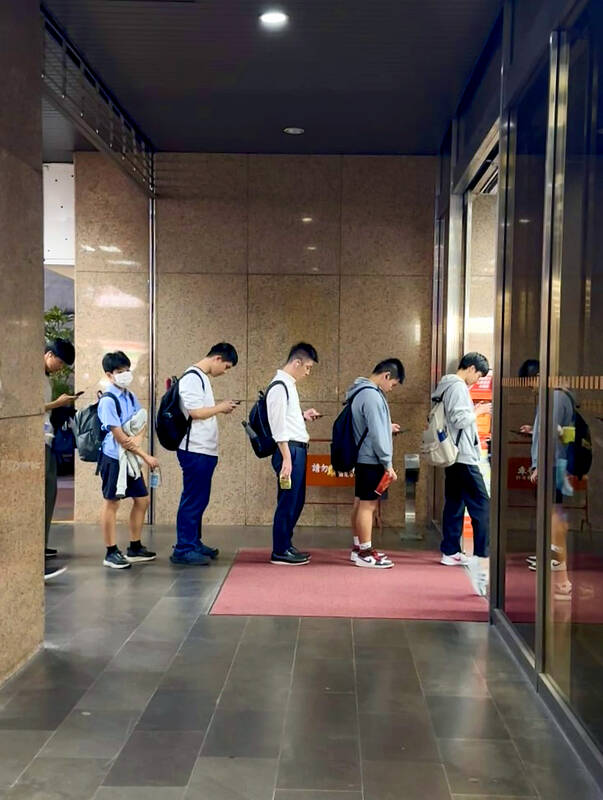The Ministry of Education last month proposed a nationwide ban on mobile devices in schools, aiming to curb concerns over student phone addiction.
Under the revised regulation, which will take effect in August, teachers and schools will be required to collect mobile devices — including phones, laptops and wearables devices — for safekeeping during school hours, unless they are being used for educational purposes.

Photo: Bonnie White
For Chang Fong-ching (張鳳琴), the ban will have a positive impact.
“It’s a good move,” says the professor in the department of health promotion and education at National Taiwan Normal University.
Chang’s research shows that phone-free schools report lower rates of smartphone and gaming addiction, as well as decreased exposure to online sexual harassment — 3.5 percent versus 7.7 percent for schools without the restrictions.

Photo: Bonnie White
However, while the ban signals a move towards addressing these issues, skepticism remains. Civic organizations and student groups say the government is being short-sighted when it comes to the realities of classroom dynamics and youth needs.
“This ban is a simple answer to a complex problem. Education should be prioritized,” says Alice Yang (楊姿潁), director of Taiwan Youth Association for Democracy (臺灣青年民主協會).
PHONE ADDICTION

Photo: Bonnie White
Ko Huei-chen (柯慧貞) says the ban is a double-edged sword. Students will eventually adapt, but some “who rely on phones for stress relief or social connection may experience distress or resistance during the adjustment period,” says Ko, a professor of psychology at Asia University and founder of the country’s first youth digital detox camps.
Ko suggests that schools guide students towards positive and intentional use of mobile devices by engaging in open dialogue about their risks and benefits.
According to a Youth Mental Health Survey released in February, Taiwanese junior and senior high school students spend an average of 35 hours on social media every week with 37.7 percent showing signs of screen addiction.
While some students sacrifice sleep over scrolling, the ban only concerns those who are glued to the screens during class.
Richard Cheng (鄭詩樵), a Health Education teacher at Taipei Municipal Jinhua Junior High School, says that he and his colleagues experience conflict with students who secretly use their phones.
“When a teacher wants to stop this behavior, [students] will get angry,” he says.
For Yang, the ban raises concerns over student rights. A student reported to her that a teacher confiscated her phone and kept it for a semester without justification.
Chang says that removing phones from the grip of students pushes their habits into the shadows, where late-night scrolling often replaces sleep as their only escape from adult control.
ADULT RESPONSIBILITY
Harold Li (李宏文), director of the Child Welfare League Foundation (兒福聯盟), says that Taiwanese children are on average more addicted to social media (20 percent) than the rest of the world (18 percent). He adds that adults should be responsible for setting the right example.
“[Adults] cannot just tell their children to not use their cell phones or the Internet while they sit on the sofa and keep scrolling,” he says.
For Li, the dialogue begins at home. He believes that parents should also be taught digital literacy — how to access, evaluate and use online content — to help bridge the divide between adults and children.
“Adults think that the carrot and the stick technique is the best way to teach a lesson but children only remember the stick,” he says.
Li says that the ban overlooks the limited communication and support between adults and children. Counselling resources in schools are stigmatised and insufficient, so students turn to the Internet for help instead.
Li adds that children understand the Internet better than adults, but these digital natives can easily be deceived and need guidance from parents and teachers to set healthy digital habits.
“If school bans incorporate elements such as emotional education, meaningful engagement and family-school collaboration, the policy is far more likely to succeed,” Ko says.

The Taipei Times last week reported that the rising share of seniors in the population is reshaping the nation’s housing markets. According to data from the Ministry of the Interior, about 850,000 residences were occupied by elderly people in the first quarter, including 655,000 that housed only one resident. H&B Realty chief researcher Jessica Hsu (徐佳馨), quoted in the article, said that there is rising demand for elderly-friendly housing, including units with elevators, barrier-free layouts and proximity to healthcare services. Hsu and others cited in the article highlighted the changing family residential dynamics, as children no longer live with parents,

It is jarring how differently Taiwan’s politics is portrayed in the international press compared to the local Chinese-language press. Viewed from abroad, Taiwan is seen as a geopolitical hotspot, or “The Most Dangerous Place on Earth,” as the Economist once blazoned across their cover. Meanwhile, tasked with facing down those existential threats, Taiwan’s leaders are dying their hair pink. These include former president Tsai Ing-wen (蔡英文), Vice President Hsiao Bi-khim (蕭美琴) and Kaohsiung Mayor Chen Chi-mai (陳其邁), among others. They are demonstrating what big fans they are of South Korean K-pop sensations Blackpink ahead of their concerts this weekend in Kaohsiung.

Oct 20 to Oct 26 After a day of fighting, the Japanese Army’s Second Division was resting when a curious delegation of two Scotsmen and 19 Taiwanese approached their camp. It was Oct. 20, 1895, and the troops had reached Taiye Village (太爺庄) in today’s Hunei District (湖內), Kaohsiung, just 10km away from their final target of Tainan. Led by Presbyterian missionaries Thomas Barclay and Duncan Ferguson, the group informed the Japanese that resistance leader Liu Yung-fu (劉永福) had fled to China the previous night, leaving his Black Flag Army fighters behind and the city in chaos. On behalf of the

I was 10 when I read an article in the local paper about the Air Guitar World Championships, which take place every year in my home town of Oulu, Finland. My parents had helped out at the very first contest back in 1996 — my mum gave out fliers, my dad sorted the music. Since then, national championships have been held all across the world, with the winners assembling in Oulu every summer. At the time, I asked my parents if I could compete. At first they were hesitant; the event was in a bar, and there would be a lot